International Business Expansion of DHL in Sri Lanka: Market Entry Strategy and Analysis
VerifiedAdded on 2023/06/11
|14
|3252
|496
AI Summary
This report focuses on the spread of business by DHL in the Sri Lankan market. DHL has been a company that has always targeted the emerging markets of Asia. In the introduction section of the report, the business context and the basic business strength of the organisation have been identified. In the Findings section, the market entry strategy of the organisation have been discussed. Most emphasis have been given on the strategic collaboration of DHL with local market peers in this section. Furthermore, in this report, a detailed analysis of the marketing and competitive customer banking of DHL has been done. The business structure of DHL in Sri Lanka have also been framed here. Lastly, strategic recommendations have also been provided in the report to ensure a faster market coverage in Sri Lanka.
Contribute Materials
Your contribution can guide someone’s learning journey. Share your
documents today.
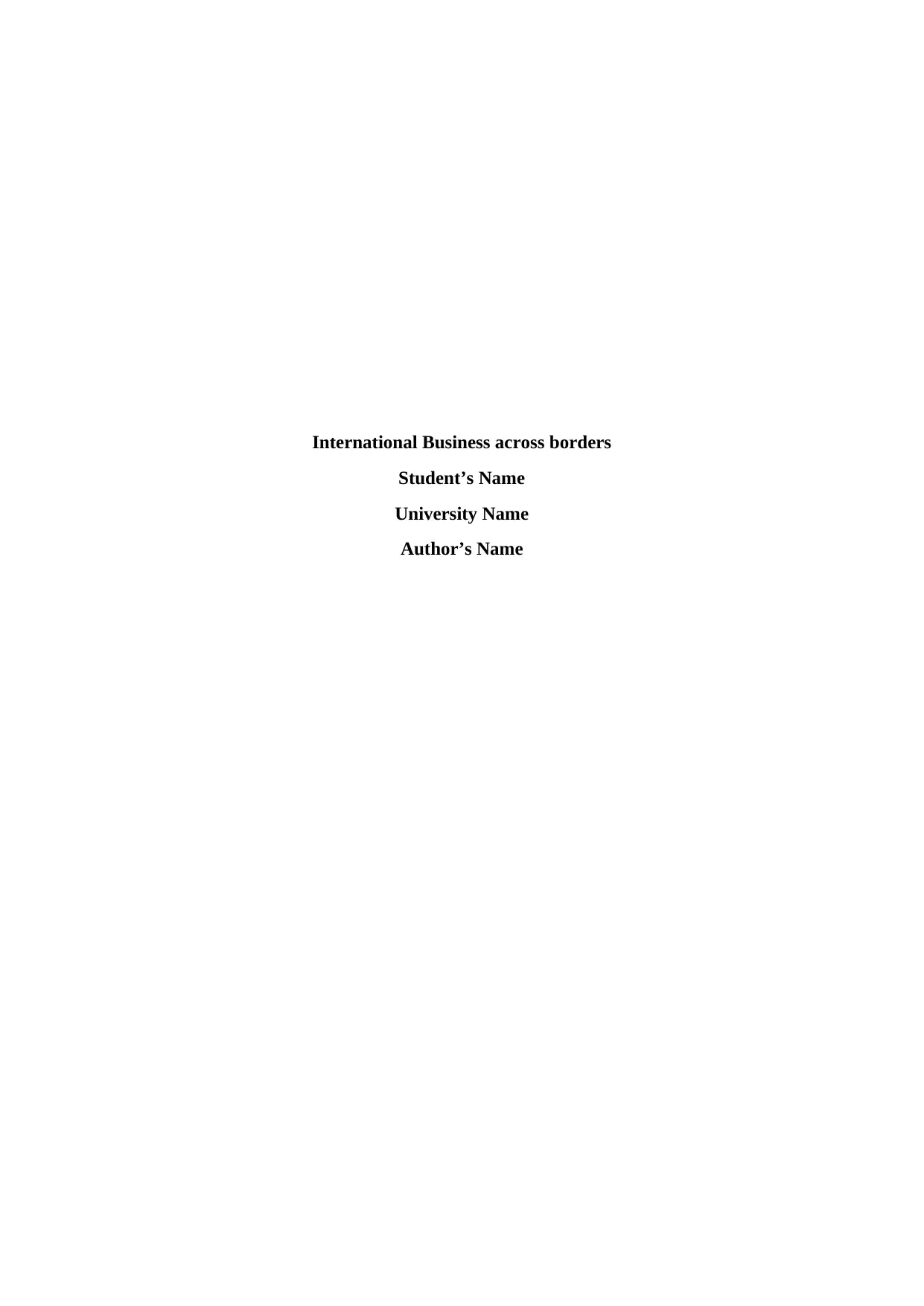
International Business across borders
Student’s Name
University Name
Author’s Name
Student’s Name
University Name
Author’s Name
Secure Best Marks with AI Grader
Need help grading? Try our AI Grader for instant feedback on your assignments.
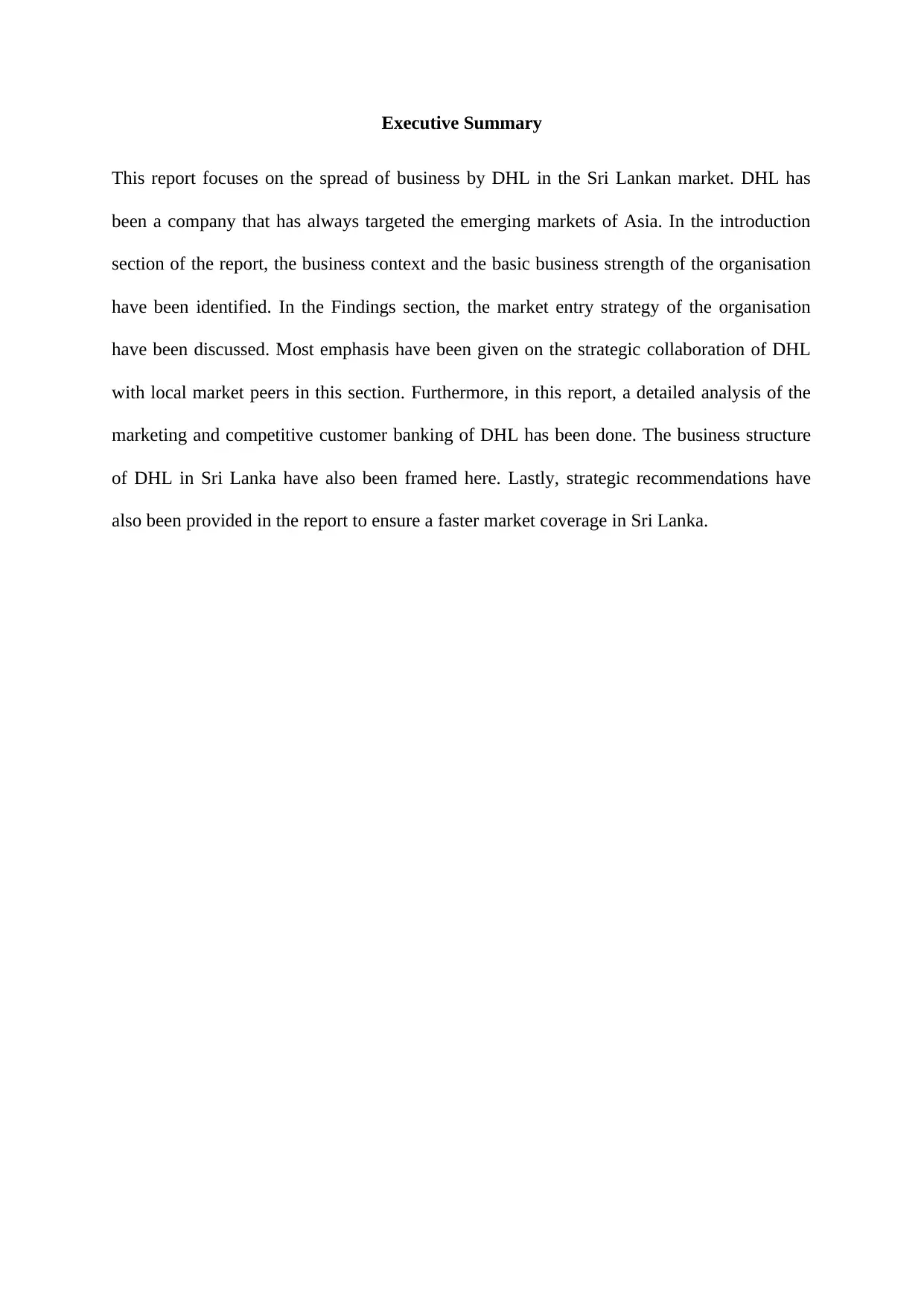
Executive Summary
This report focuses on the spread of business by DHL in the Sri Lankan market. DHL has
been a company that has always targeted the emerging markets of Asia. In the introduction
section of the report, the business context and the basic business strength of the organisation
have been identified. In the Findings section, the market entry strategy of the organisation
have been discussed. Most emphasis have been given on the strategic collaboration of DHL
with local market peers in this section. Furthermore, in this report, a detailed analysis of the
marketing and competitive customer banking of DHL has been done. The business structure
of DHL in Sri Lanka have also been framed here. Lastly, strategic recommendations have
also been provided in the report to ensure a faster market coverage in Sri Lanka.
This report focuses on the spread of business by DHL in the Sri Lankan market. DHL has
been a company that has always targeted the emerging markets of Asia. In the introduction
section of the report, the business context and the basic business strength of the organisation
have been identified. In the Findings section, the market entry strategy of the organisation
have been discussed. Most emphasis have been given on the strategic collaboration of DHL
with local market peers in this section. Furthermore, in this report, a detailed analysis of the
marketing and competitive customer banking of DHL has been done. The business structure
of DHL in Sri Lanka have also been framed here. Lastly, strategic recommendations have
also been provided in the report to ensure a faster market coverage in Sri Lanka.
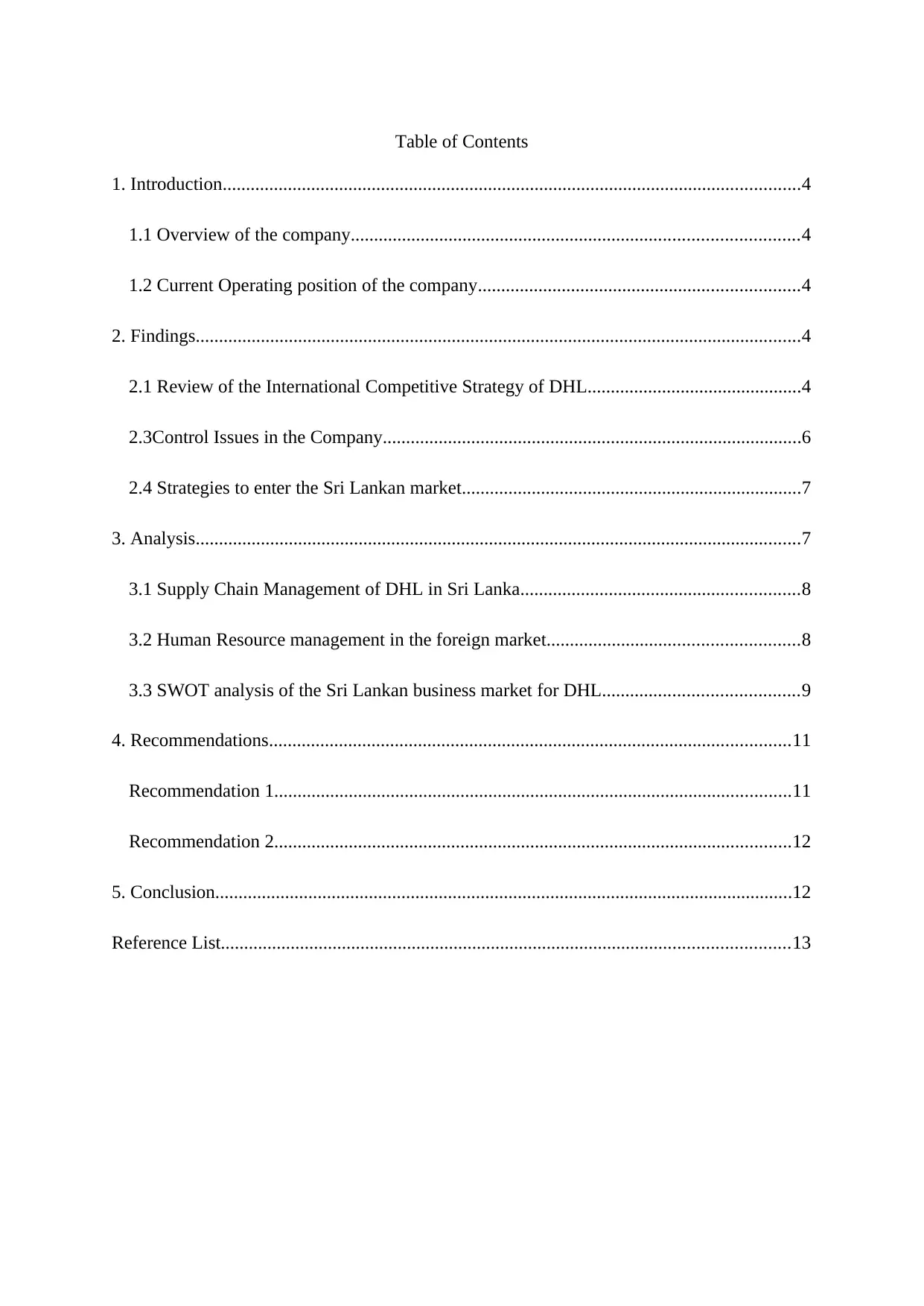
Table of Contents
1. Introduction............................................................................................................................4
1.1 Overview of the company................................................................................................4
1.2 Current Operating position of the company.....................................................................4
2. Findings..................................................................................................................................4
2.1 Review of the International Competitive Strategy of DHL..............................................4
2.3Control Issues in the Company..........................................................................................6
2.4 Strategies to enter the Sri Lankan market.........................................................................7
3. Analysis..................................................................................................................................7
3.1 Supply Chain Management of DHL in Sri Lanka............................................................8
3.2 Human Resource management in the foreign market......................................................8
3.3 SWOT analysis of the Sri Lankan business market for DHL..........................................9
4. Recommendations................................................................................................................11
Recommendation 1...............................................................................................................11
Recommendation 2...............................................................................................................12
5. Conclusion............................................................................................................................12
Reference List..........................................................................................................................13
1. Introduction............................................................................................................................4
1.1 Overview of the company................................................................................................4
1.2 Current Operating position of the company.....................................................................4
2. Findings..................................................................................................................................4
2.1 Review of the International Competitive Strategy of DHL..............................................4
2.3Control Issues in the Company..........................................................................................6
2.4 Strategies to enter the Sri Lankan market.........................................................................7
3. Analysis..................................................................................................................................7
3.1 Supply Chain Management of DHL in Sri Lanka............................................................8
3.2 Human Resource management in the foreign market......................................................8
3.3 SWOT analysis of the Sri Lankan business market for DHL..........................................9
4. Recommendations................................................................................................................11
Recommendation 1...............................................................................................................11
Recommendation 2...............................................................................................................12
5. Conclusion............................................................................................................................12
Reference List..........................................................................................................................13
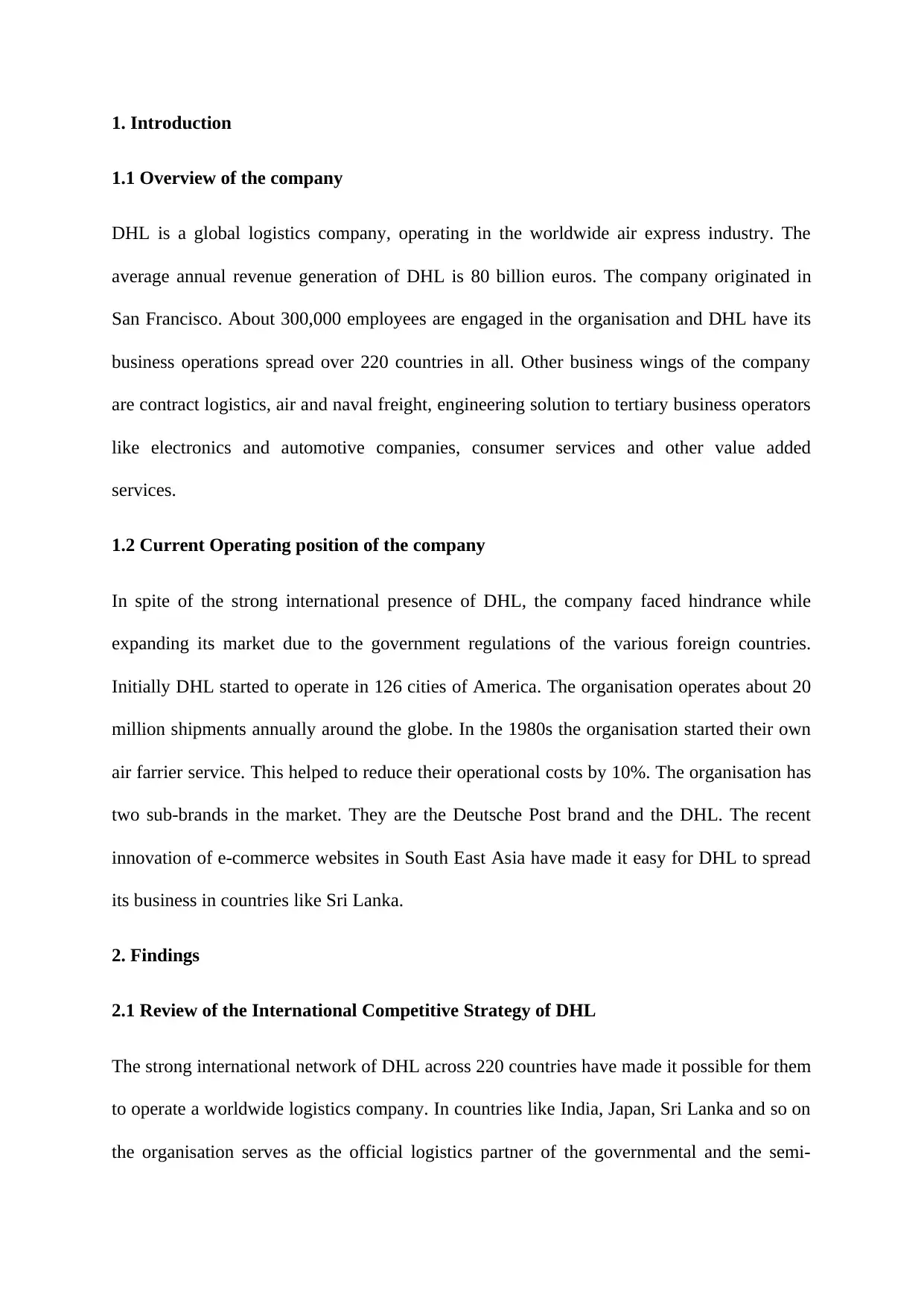
1. Introduction
1.1 Overview of the company
DHL is a global logistics company, operating in the worldwide air express industry. The
average annual revenue generation of DHL is 80 billion euros. The company originated in
San Francisco. About 300,000 employees are engaged in the organisation and DHL have its
business operations spread over 220 countries in all. Other business wings of the company
are contract logistics, air and naval freight, engineering solution to tertiary business operators
like electronics and automotive companies, consumer services and other value added
services.
1.2 Current Operating position of the company
In spite of the strong international presence of DHL, the company faced hindrance while
expanding its market due to the government regulations of the various foreign countries.
Initially DHL started to operate in 126 cities of America. The organisation operates about 20
million shipments annually around the globe. In the 1980s the organisation started their own
air farrier service. This helped to reduce their operational costs by 10%. The organisation has
two sub-brands in the market. They are the Deutsche Post brand and the DHL. The recent
innovation of e-commerce websites in South East Asia have made it easy for DHL to spread
its business in countries like Sri Lanka.
2. Findings
2.1 Review of the International Competitive Strategy of DHL
The strong international network of DHL across 220 countries have made it possible for them
to operate a worldwide logistics company. In countries like India, Japan, Sri Lanka and so on
the organisation serves as the official logistics partner of the governmental and the semi-
1.1 Overview of the company
DHL is a global logistics company, operating in the worldwide air express industry. The
average annual revenue generation of DHL is 80 billion euros. The company originated in
San Francisco. About 300,000 employees are engaged in the organisation and DHL have its
business operations spread over 220 countries in all. Other business wings of the company
are contract logistics, air and naval freight, engineering solution to tertiary business operators
like electronics and automotive companies, consumer services and other value added
services.
1.2 Current Operating position of the company
In spite of the strong international presence of DHL, the company faced hindrance while
expanding its market due to the government regulations of the various foreign countries.
Initially DHL started to operate in 126 cities of America. The organisation operates about 20
million shipments annually around the globe. In the 1980s the organisation started their own
air farrier service. This helped to reduce their operational costs by 10%. The organisation has
two sub-brands in the market. They are the Deutsche Post brand and the DHL. The recent
innovation of e-commerce websites in South East Asia have made it easy for DHL to spread
its business in countries like Sri Lanka.
2. Findings
2.1 Review of the International Competitive Strategy of DHL
The strong international network of DHL across 220 countries have made it possible for them
to operate a worldwide logistics company. In countries like India, Japan, Sri Lanka and so on
the organisation serves as the official logistics partner of the governmental and the semi-
Secure Best Marks with AI Grader
Need help grading? Try our AI Grader for instant feedback on your assignments.
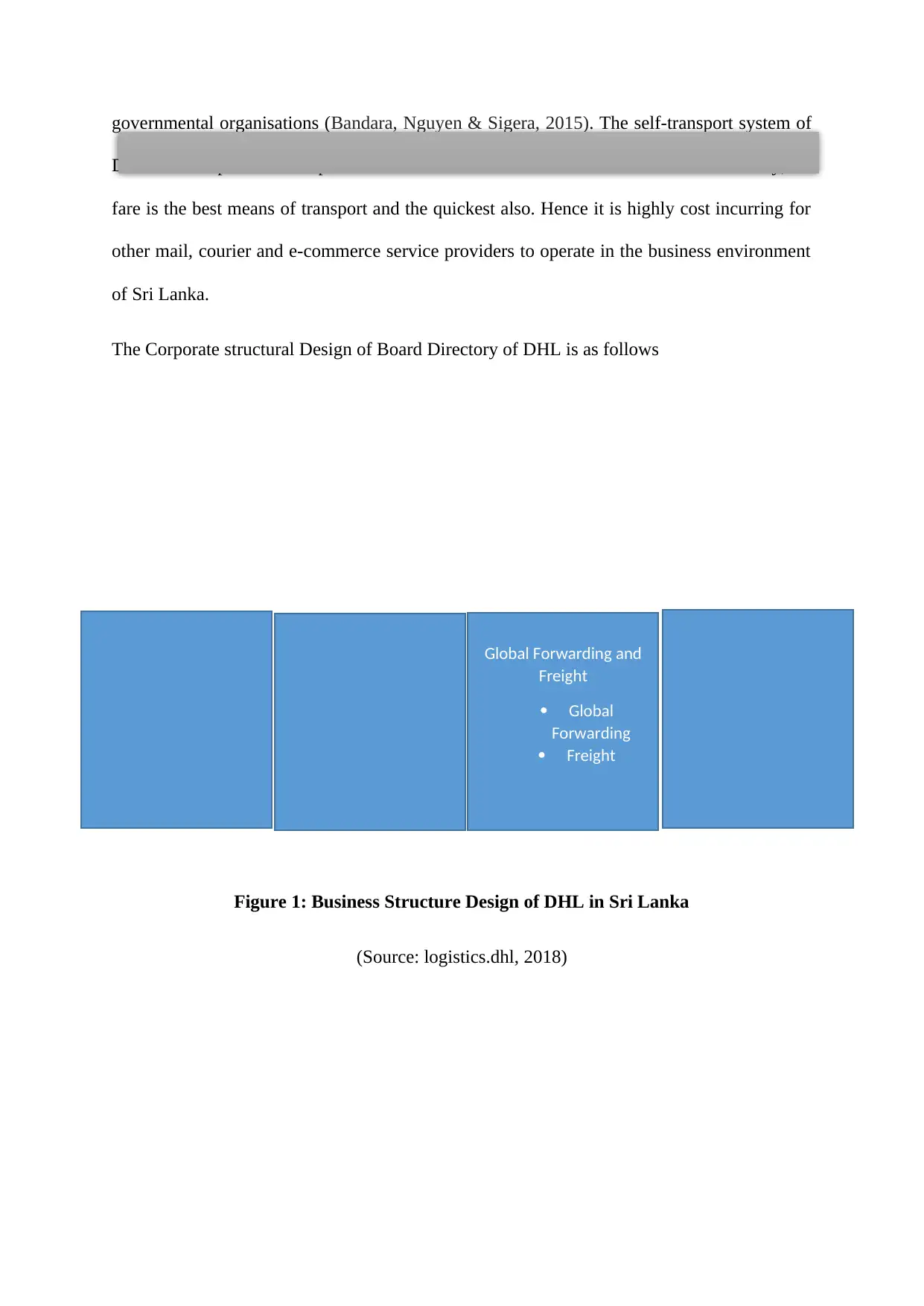
governmental organisations (Bandara, Nguyen & Sigera, 2015). The self-transport system of
DHL have helped them to spread their business in Sri Lanka. Since it is an island country, air
fare is the best means of transport and the quickest also. Hence it is highly cost incurring for
other mail, courier and e-commerce service providers to operate in the business environment
of Sri Lanka.
The Corporate structural Design of Board Directory of DHL is as follows
Figure 1: Business Structure Design of DHL in Sri Lanka
(Source: logistics.dhl, 2018)
Global Forwarding and
Freight
Global
Forwarding
Freight
DHL have helped them to spread their business in Sri Lanka. Since it is an island country, air
fare is the best means of transport and the quickest also. Hence it is highly cost incurring for
other mail, courier and e-commerce service providers to operate in the business environment
of Sri Lanka.
The Corporate structural Design of Board Directory of DHL is as follows
Figure 1: Business Structure Design of DHL in Sri Lanka
(Source: logistics.dhl, 2018)
Global Forwarding and
Freight
Global
Forwarding
Freight

Figure 2: Organic Chart of Business Operations of DHL in Sri Lanka
(Source: logistics.dhl, 2018)
2.3Control Issues in the Company
Although DHL is successfully executing its business in Sri Lanka for more than 35 years,
they have faced some prominent internal control issues. The first area of concern is poor rate
of addressing customers’ grievances. DHL have a customer complaint lodging facility. In a
logistics business customer interaction is complimentary demand and a regular business
transaction. Hence, addressing the issues that customers face is necessary (Banerjee, 2017).
Moreover, in Sri Lanka, due to abrupt topographical design and weather problems, logistics
and freight have been problematic. Naturally, the number of queries that customers raises are
high.
Company Management
Division A Division B
Logistics
Production
Marketing
Administration
Division C
Logistics
Finance and Human
Resources Logistics
(Source: logistics.dhl, 2018)
2.3Control Issues in the Company
Although DHL is successfully executing its business in Sri Lanka for more than 35 years,
they have faced some prominent internal control issues. The first area of concern is poor rate
of addressing customers’ grievances. DHL have a customer complaint lodging facility. In a
logistics business customer interaction is complimentary demand and a regular business
transaction. Hence, addressing the issues that customers face is necessary (Banerjee, 2017).
Moreover, in Sri Lanka, due to abrupt topographical design and weather problems, logistics
and freight have been problematic. Naturally, the number of queries that customers raises are
high.
Company Management
Division A Division B
Logistics
Production
Marketing
Administration
Division C
Logistics
Finance and Human
Resources Logistics
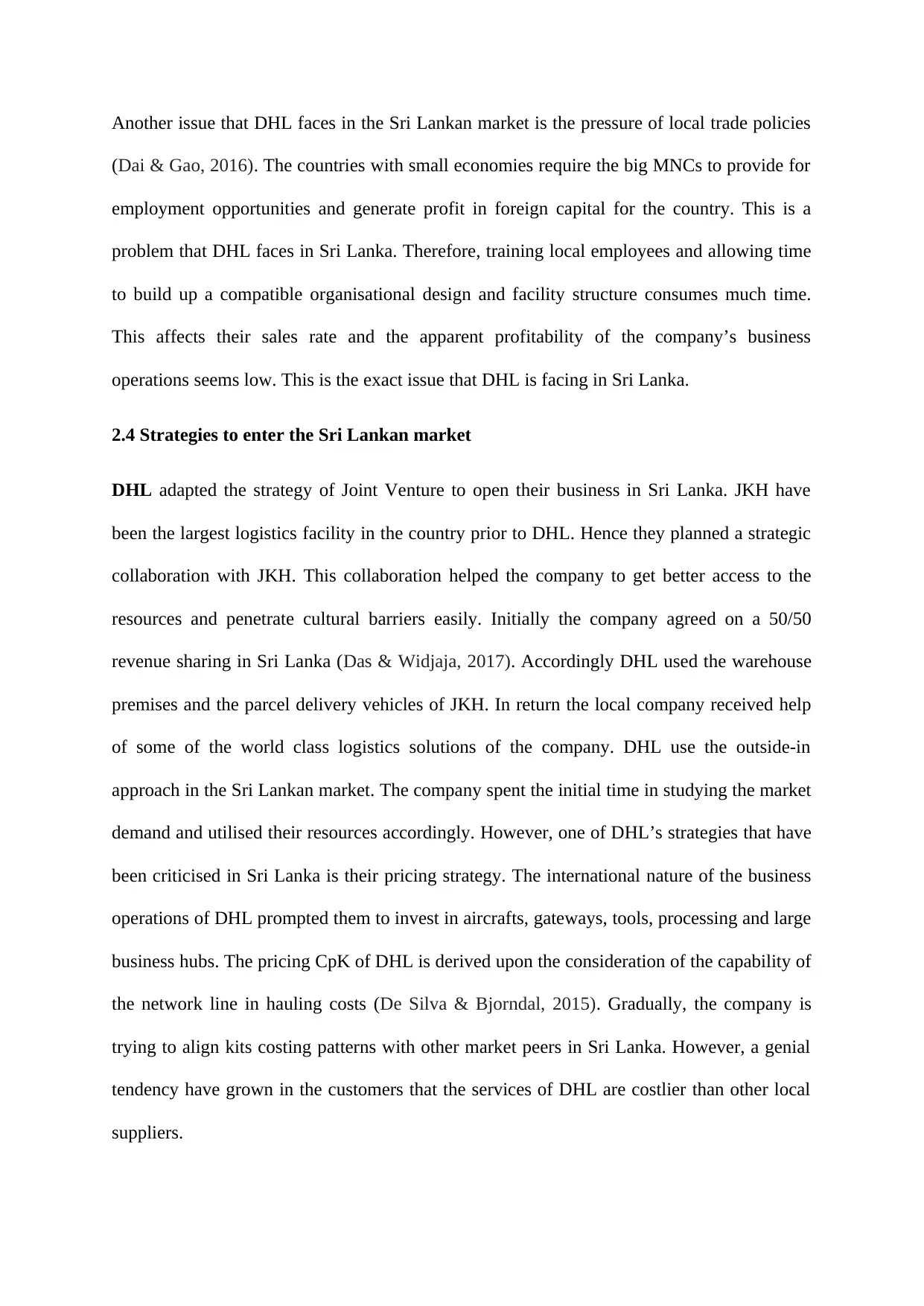
Another issue that DHL faces in the Sri Lankan market is the pressure of local trade policies
(Dai & Gao, 2016). The countries with small economies require the big MNCs to provide for
employment opportunities and generate profit in foreign capital for the country. This is a
problem that DHL faces in Sri Lanka. Therefore, training local employees and allowing time
to build up a compatible organisational design and facility structure consumes much time.
This affects their sales rate and the apparent profitability of the company’s business
operations seems low. This is the exact issue that DHL is facing in Sri Lanka.
2.4 Strategies to enter the Sri Lankan market
DHL adapted the strategy of Joint Venture to open their business in Sri Lanka. JKH have
been the largest logistics facility in the country prior to DHL. Hence they planned a strategic
collaboration with JKH. This collaboration helped the company to get better access to the
resources and penetrate cultural barriers easily. Initially the company agreed on a 50/50
revenue sharing in Sri Lanka (Das & Widjaja, 2017). Accordingly DHL used the warehouse
premises and the parcel delivery vehicles of JKH. In return the local company received help
of some of the world class logistics solutions of the company. DHL use the outside-in
approach in the Sri Lankan market. The company spent the initial time in studying the market
demand and utilised their resources accordingly. However, one of DHL’s strategies that have
been criticised in Sri Lanka is their pricing strategy. The international nature of the business
operations of DHL prompted them to invest in aircrafts, gateways, tools, processing and large
business hubs. The pricing CpK of DHL is derived upon the consideration of the capability of
the network line in hauling costs (De Silva & Bjorndal, 2015). Gradually, the company is
trying to align kits costing patterns with other market peers in Sri Lanka. However, a genial
tendency have grown in the customers that the services of DHL are costlier than other local
suppliers.
(Dai & Gao, 2016). The countries with small economies require the big MNCs to provide for
employment opportunities and generate profit in foreign capital for the country. This is a
problem that DHL faces in Sri Lanka. Therefore, training local employees and allowing time
to build up a compatible organisational design and facility structure consumes much time.
This affects their sales rate and the apparent profitability of the company’s business
operations seems low. This is the exact issue that DHL is facing in Sri Lanka.
2.4 Strategies to enter the Sri Lankan market
DHL adapted the strategy of Joint Venture to open their business in Sri Lanka. JKH have
been the largest logistics facility in the country prior to DHL. Hence they planned a strategic
collaboration with JKH. This collaboration helped the company to get better access to the
resources and penetrate cultural barriers easily. Initially the company agreed on a 50/50
revenue sharing in Sri Lanka (Das & Widjaja, 2017). Accordingly DHL used the warehouse
premises and the parcel delivery vehicles of JKH. In return the local company received help
of some of the world class logistics solutions of the company. DHL use the outside-in
approach in the Sri Lankan market. The company spent the initial time in studying the market
demand and utilised their resources accordingly. However, one of DHL’s strategies that have
been criticised in Sri Lanka is their pricing strategy. The international nature of the business
operations of DHL prompted them to invest in aircrafts, gateways, tools, processing and large
business hubs. The pricing CpK of DHL is derived upon the consideration of the capability of
the network line in hauling costs (De Silva & Bjorndal, 2015). Gradually, the company is
trying to align kits costing patterns with other market peers in Sri Lanka. However, a genial
tendency have grown in the customers that the services of DHL are costlier than other local
suppliers.
Paraphrase This Document
Need a fresh take? Get an instant paraphrase of this document with our AI Paraphraser
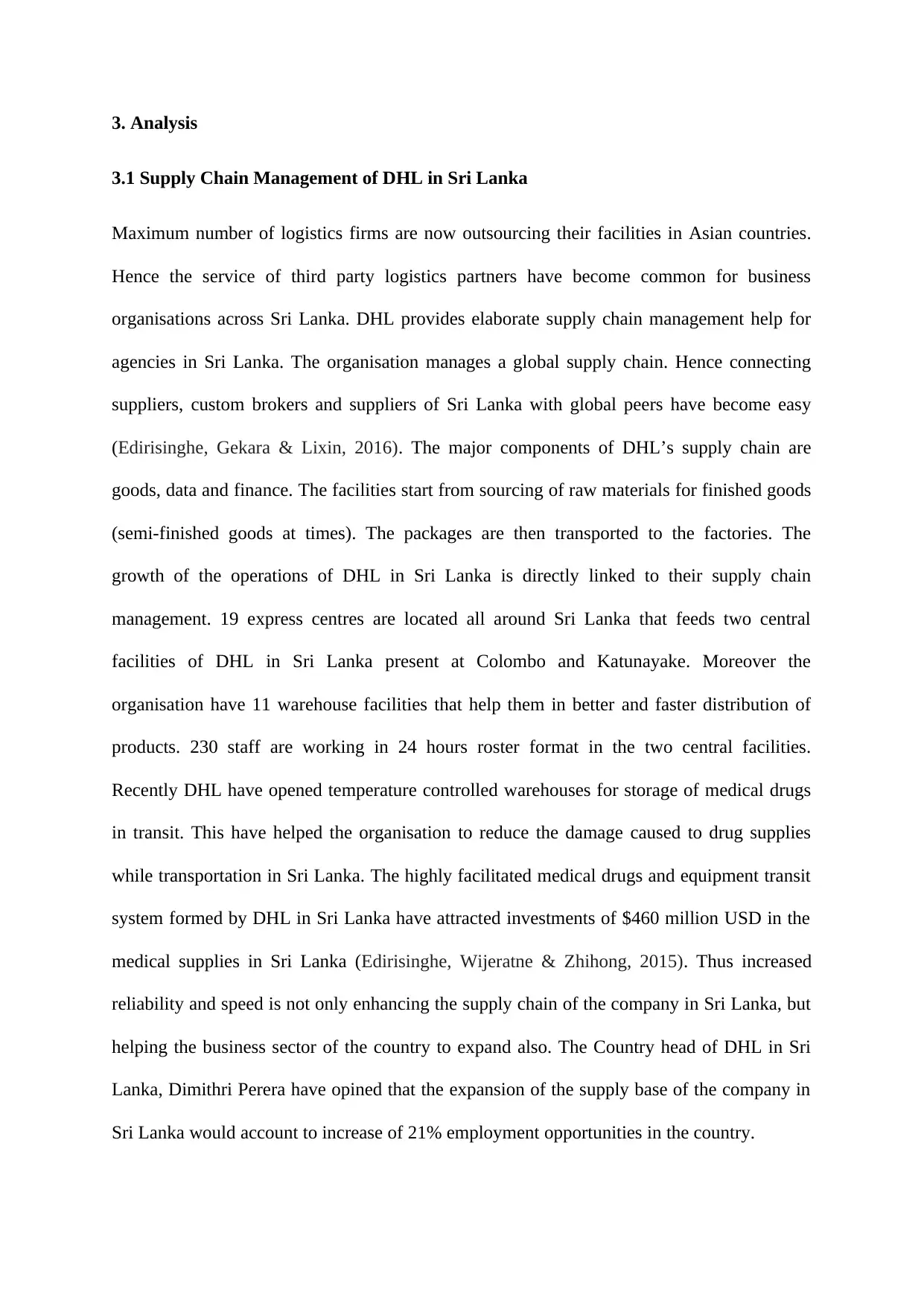
3. Analysis
3.1 Supply Chain Management of DHL in Sri Lanka
Maximum number of logistics firms are now outsourcing their facilities in Asian countries.
Hence the service of third party logistics partners have become common for business
organisations across Sri Lanka. DHL provides elaborate supply chain management help for
agencies in Sri Lanka. The organisation manages a global supply chain. Hence connecting
suppliers, custom brokers and suppliers of Sri Lanka with global peers have become easy
(Edirisinghe, Gekara & Lixin, 2016). The major components of DHL’s supply chain are
goods, data and finance. The facilities start from sourcing of raw materials for finished goods
(semi-finished goods at times). The packages are then transported to the factories. The
growth of the operations of DHL in Sri Lanka is directly linked to their supply chain
management. 19 express centres are located all around Sri Lanka that feeds two central
facilities of DHL in Sri Lanka present at Colombo and Katunayake. Moreover the
organisation have 11 warehouse facilities that help them in better and faster distribution of
products. 230 staff are working in 24 hours roster format in the two central facilities.
Recently DHL have opened temperature controlled warehouses for storage of medical drugs
in transit. This have helped the organisation to reduce the damage caused to drug supplies
while transportation in Sri Lanka. The highly facilitated medical drugs and equipment transit
system formed by DHL in Sri Lanka have attracted investments of $460 million USD in the
medical supplies in Sri Lanka (Edirisinghe, Wijeratne & Zhihong, 2015). Thus increased
reliability and speed is not only enhancing the supply chain of the company in Sri Lanka, but
helping the business sector of the country to expand also. The Country head of DHL in Sri
Lanka, Dimithri Perera have opined that the expansion of the supply base of the company in
Sri Lanka would account to increase of 21% employment opportunities in the country.
3.1 Supply Chain Management of DHL in Sri Lanka
Maximum number of logistics firms are now outsourcing their facilities in Asian countries.
Hence the service of third party logistics partners have become common for business
organisations across Sri Lanka. DHL provides elaborate supply chain management help for
agencies in Sri Lanka. The organisation manages a global supply chain. Hence connecting
suppliers, custom brokers and suppliers of Sri Lanka with global peers have become easy
(Edirisinghe, Gekara & Lixin, 2016). The major components of DHL’s supply chain are
goods, data and finance. The facilities start from sourcing of raw materials for finished goods
(semi-finished goods at times). The packages are then transported to the factories. The
growth of the operations of DHL in Sri Lanka is directly linked to their supply chain
management. 19 express centres are located all around Sri Lanka that feeds two central
facilities of DHL in Sri Lanka present at Colombo and Katunayake. Moreover the
organisation have 11 warehouse facilities that help them in better and faster distribution of
products. 230 staff are working in 24 hours roster format in the two central facilities.
Recently DHL have opened temperature controlled warehouses for storage of medical drugs
in transit. This have helped the organisation to reduce the damage caused to drug supplies
while transportation in Sri Lanka. The highly facilitated medical drugs and equipment transit
system formed by DHL in Sri Lanka have attracted investments of $460 million USD in the
medical supplies in Sri Lanka (Edirisinghe, Wijeratne & Zhihong, 2015). Thus increased
reliability and speed is not only enhancing the supply chain of the company in Sri Lanka, but
helping the business sector of the country to expand also. The Country head of DHL in Sri
Lanka, Dimithri Perera have opined that the expansion of the supply base of the company in
Sri Lanka would account to increase of 21% employment opportunities in the country.
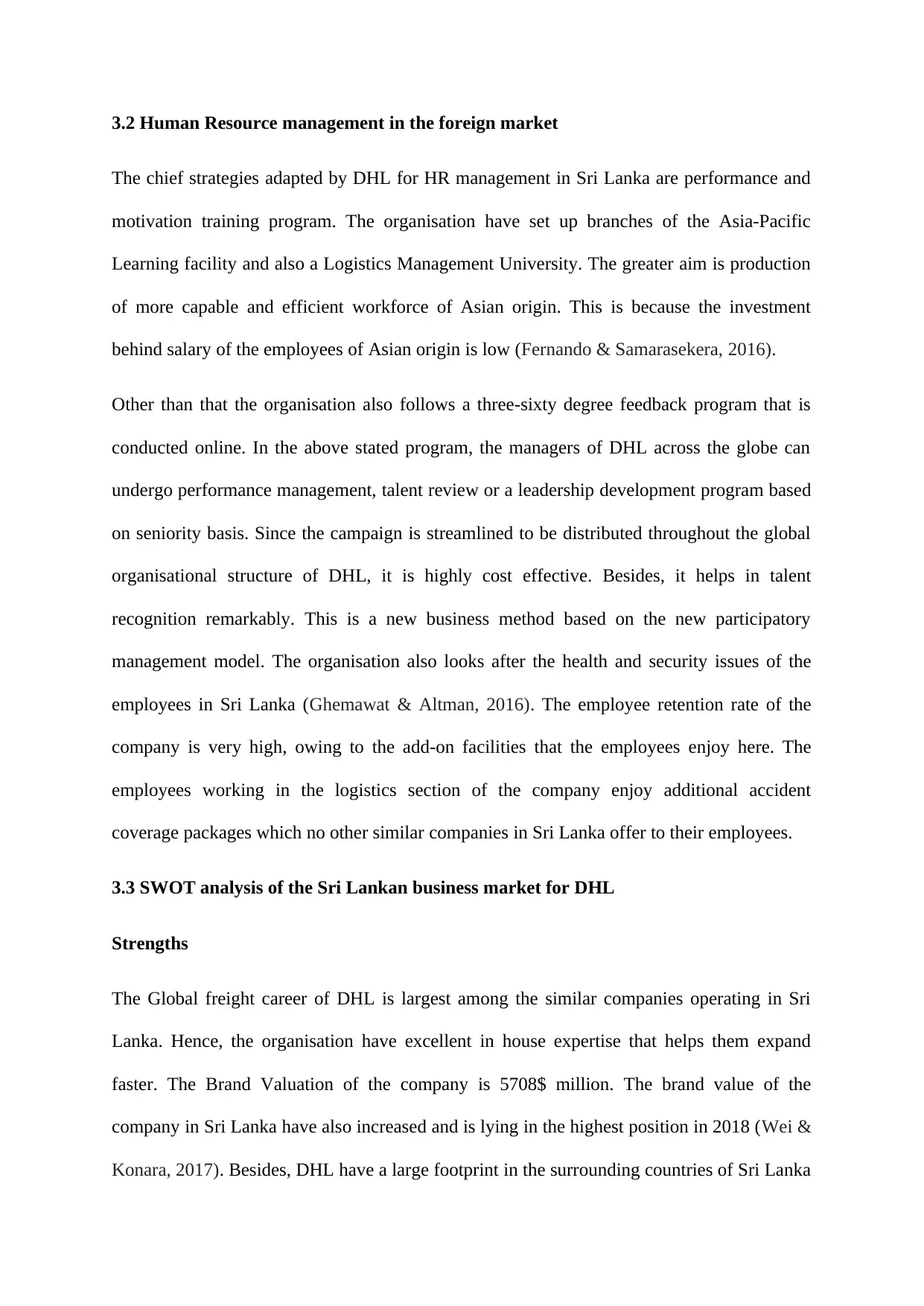
3.2 Human Resource management in the foreign market
The chief strategies adapted by DHL for HR management in Sri Lanka are performance and
motivation training program. The organisation have set up branches of the Asia-Pacific
Learning facility and also a Logistics Management University. The greater aim is production
of more capable and efficient workforce of Asian origin. This is because the investment
behind salary of the employees of Asian origin is low (Fernando & Samarasekera, 2016).
Other than that the organisation also follows a three-sixty degree feedback program that is
conducted online. In the above stated program, the managers of DHL across the globe can
undergo performance management, talent review or a leadership development program based
on seniority basis. Since the campaign is streamlined to be distributed throughout the global
organisational structure of DHL, it is highly cost effective. Besides, it helps in talent
recognition remarkably. This is a new business method based on the new participatory
management model. The organisation also looks after the health and security issues of the
employees in Sri Lanka (Ghemawat & Altman, 2016). The employee retention rate of the
company is very high, owing to the add-on facilities that the employees enjoy here. The
employees working in the logistics section of the company enjoy additional accident
coverage packages which no other similar companies in Sri Lanka offer to their employees.
3.3 SWOT analysis of the Sri Lankan business market for DHL
Strengths
The Global freight career of DHL is largest among the similar companies operating in Sri
Lanka. Hence, the organisation have excellent in house expertise that helps them expand
faster. The Brand Valuation of the company is 5708$ million. The brand value of the
company in Sri Lanka have also increased and is lying in the highest position in 2018 (Wei &
Konara, 2017). Besides, DHL have a large footprint in the surrounding countries of Sri Lanka
The chief strategies adapted by DHL for HR management in Sri Lanka are performance and
motivation training program. The organisation have set up branches of the Asia-Pacific
Learning facility and also a Logistics Management University. The greater aim is production
of more capable and efficient workforce of Asian origin. This is because the investment
behind salary of the employees of Asian origin is low (Fernando & Samarasekera, 2016).
Other than that the organisation also follows a three-sixty degree feedback program that is
conducted online. In the above stated program, the managers of DHL across the globe can
undergo performance management, talent review or a leadership development program based
on seniority basis. Since the campaign is streamlined to be distributed throughout the global
organisational structure of DHL, it is highly cost effective. Besides, it helps in talent
recognition remarkably. This is a new business method based on the new participatory
management model. The organisation also looks after the health and security issues of the
employees in Sri Lanka (Ghemawat & Altman, 2016). The employee retention rate of the
company is very high, owing to the add-on facilities that the employees enjoy here. The
employees working in the logistics section of the company enjoy additional accident
coverage packages which no other similar companies in Sri Lanka offer to their employees.
3.3 SWOT analysis of the Sri Lankan business market for DHL
Strengths
The Global freight career of DHL is largest among the similar companies operating in Sri
Lanka. Hence, the organisation have excellent in house expertise that helps them expand
faster. The Brand Valuation of the company is 5708$ million. The brand value of the
company in Sri Lanka have also increased and is lying in the highest position in 2018 (Wei &
Konara, 2017). Besides, DHL have a large footprint in the surrounding countries of Sri Lanka

like India, Bangladesh and Myanmar (Griffith & Zhao, 2015). This has helped the company
to earn the trust of more agencies who have started working with DHL as their strategic
freight partner.
Weaknesses
The market share growth of DHL have not been sufficient in Sri Lanka. Presence of large
number of local small and big competitors have made it difficult for DHL to expand the
market share. The accumulated share of the local companies account to be more than 60%
(Tennakoon, Gunawardana &Amarathunga, 2015). High investments are another weakness
o9f the company. The industry in which DHL is operating, requires heavy initial investments.
Moreover, the return on the investments is not immediate. Moreover, since the beginning of
its operations in Sri Lanka, DHL have worked in strategic collaboration with external
agencies. Hence, this creates an excess dependence on the external peers with whom the
organisation shares its business domain. Lastly, poor marketing is another important
weakness (Hettiarachchi & Ranwala, 2015). Compared to the marketing campaigns of its
other peers like FedEx or UPS, DHL makes minimal investment on marketing in Sri Lanka.
Opportunities
DHL has set its foot in the business domain of Sri Lanka before any other global market peer.
Hence, the emerging market of Sri Lanka would provide a lot of business opportunities to
DHL in the future. Another change in the macro environment of Sri Lanka is the spread of e-
commerce business. Hence, DHL would become the first choice of the e-commerce
companies for strategic collaboration as third party logistics partners (Perry, Wood & Fernie,
2015).
Threats
to earn the trust of more agencies who have started working with DHL as their strategic
freight partner.
Weaknesses
The market share growth of DHL have not been sufficient in Sri Lanka. Presence of large
number of local small and big competitors have made it difficult for DHL to expand the
market share. The accumulated share of the local companies account to be more than 60%
(Tennakoon, Gunawardana &Amarathunga, 2015). High investments are another weakness
o9f the company. The industry in which DHL is operating, requires heavy initial investments.
Moreover, the return on the investments is not immediate. Moreover, since the beginning of
its operations in Sri Lanka, DHL have worked in strategic collaboration with external
agencies. Hence, this creates an excess dependence on the external peers with whom the
organisation shares its business domain. Lastly, poor marketing is another important
weakness (Hettiarachchi & Ranwala, 2015). Compared to the marketing campaigns of its
other peers like FedEx or UPS, DHL makes minimal investment on marketing in Sri Lanka.
Opportunities
DHL has set its foot in the business domain of Sri Lanka before any other global market peer.
Hence, the emerging market of Sri Lanka would provide a lot of business opportunities to
DHL in the future. Another change in the macro environment of Sri Lanka is the spread of e-
commerce business. Hence, DHL would become the first choice of the e-commerce
companies for strategic collaboration as third party logistics partners (Perry, Wood & Fernie,
2015).
Threats
Secure Best Marks with AI Grader
Need help grading? Try our AI Grader for instant feedback on your assignments.
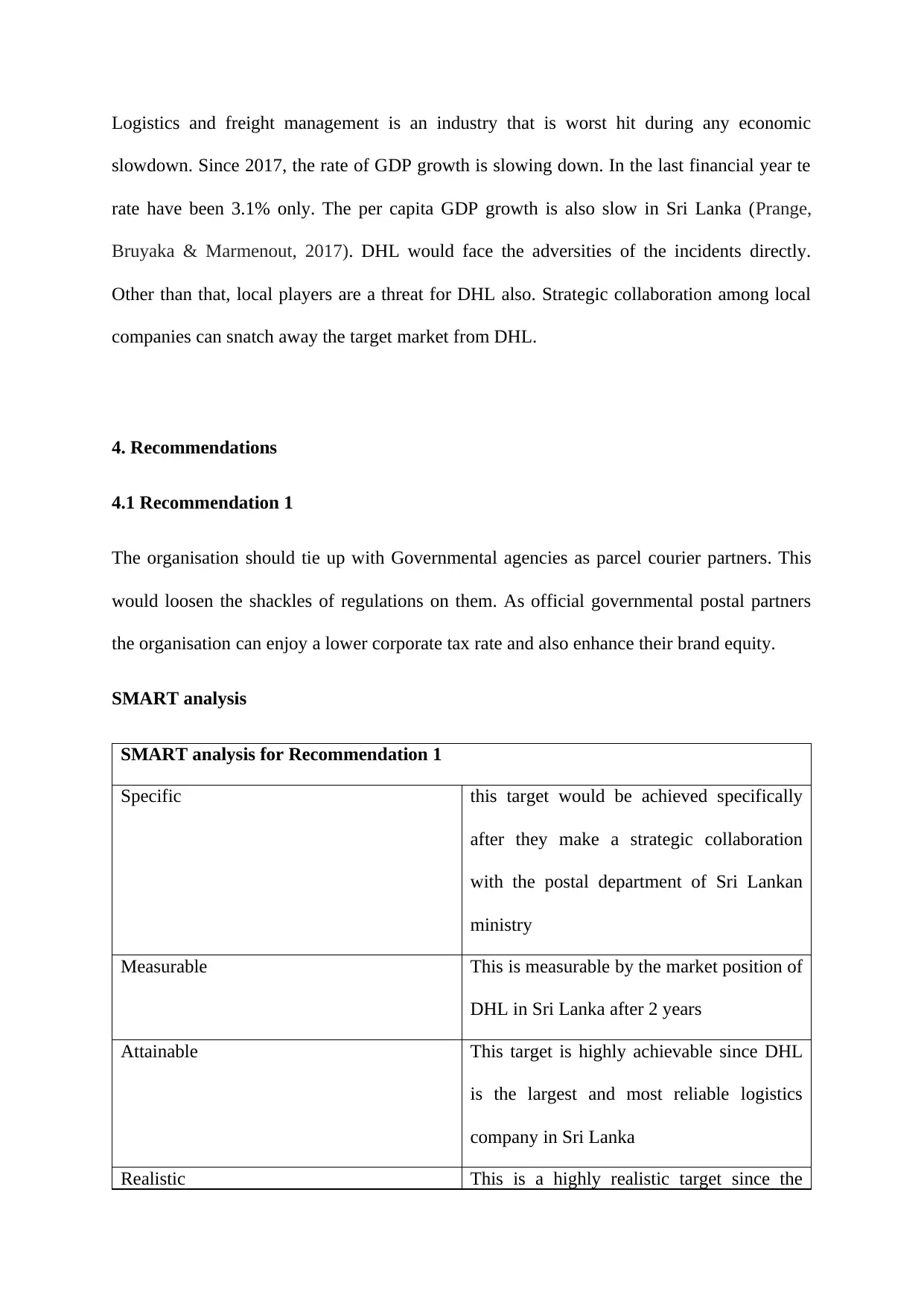
Logistics and freight management is an industry that is worst hit during any economic
slowdown. Since 2017, the rate of GDP growth is slowing down. In the last financial year te
rate have been 3.1% only. The per capita GDP growth is also slow in Sri Lanka (Prange,
Bruyaka & Marmenout, 2017). DHL would face the adversities of the incidents directly.
Other than that, local players are a threat for DHL also. Strategic collaboration among local
companies can snatch away the target market from DHL.
4. Recommendations
4.1 Recommendation 1
The organisation should tie up with Governmental agencies as parcel courier partners. This
would loosen the shackles of regulations on them. As official governmental postal partners
the organisation can enjoy a lower corporate tax rate and also enhance their brand equity.
SMART analysis
SMART analysis for Recommendation 1
Specific this target would be achieved specifically
after they make a strategic collaboration
with the postal department of Sri Lankan
ministry
Measurable This is measurable by the market position of
DHL in Sri Lanka after 2 years
Attainable This target is highly achievable since DHL
is the largest and most reliable logistics
company in Sri Lanka
Realistic This is a highly realistic target since the
slowdown. Since 2017, the rate of GDP growth is slowing down. In the last financial year te
rate have been 3.1% only. The per capita GDP growth is also slow in Sri Lanka (Prange,
Bruyaka & Marmenout, 2017). DHL would face the adversities of the incidents directly.
Other than that, local players are a threat for DHL also. Strategic collaboration among local
companies can snatch away the target market from DHL.
4. Recommendations
4.1 Recommendation 1
The organisation should tie up with Governmental agencies as parcel courier partners. This
would loosen the shackles of regulations on them. As official governmental postal partners
the organisation can enjoy a lower corporate tax rate and also enhance their brand equity.
SMART analysis
SMART analysis for Recommendation 1
Specific this target would be achieved specifically
after they make a strategic collaboration
with the postal department of Sri Lankan
ministry
Measurable This is measurable by the market position of
DHL in Sri Lanka after 2 years
Attainable This target is highly achievable since DHL
is the largest and most reliable logistics
company in Sri Lanka
Realistic This is a highly realistic target since the
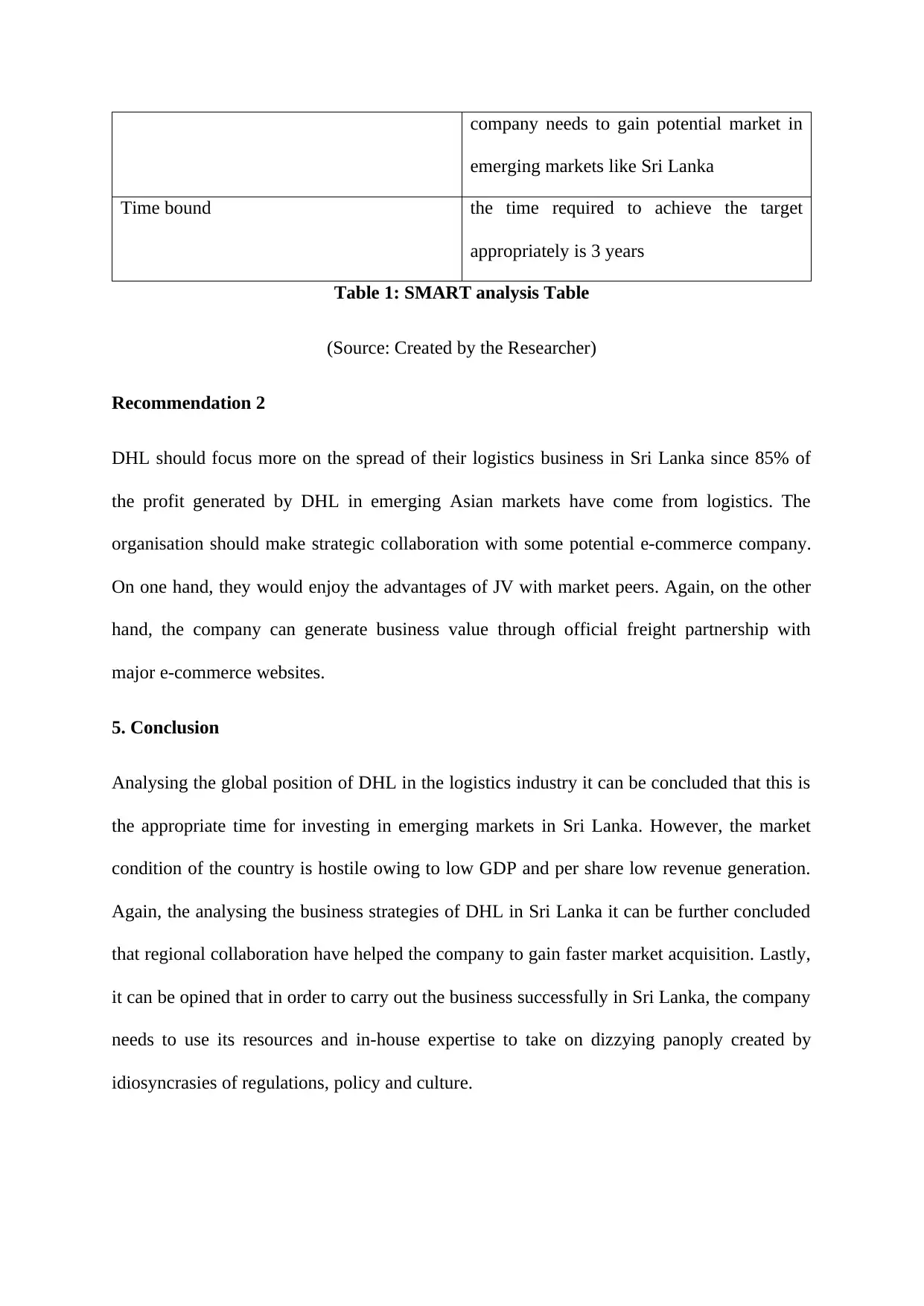
company needs to gain potential market in
emerging markets like Sri Lanka
Time bound the time required to achieve the target
appropriately is 3 years
Table 1: SMART analysis Table
(Source: Created by the Researcher)
Recommendation 2
DHL should focus more on the spread of their logistics business in Sri Lanka since 85% of
the profit generated by DHL in emerging Asian markets have come from logistics. The
organisation should make strategic collaboration with some potential e-commerce company.
On one hand, they would enjoy the advantages of JV with market peers. Again, on the other
hand, the company can generate business value through official freight partnership with
major e-commerce websites.
5. Conclusion
Analysing the global position of DHL in the logistics industry it can be concluded that this is
the appropriate time for investing in emerging markets in Sri Lanka. However, the market
condition of the country is hostile owing to low GDP and per share low revenue generation.
Again, the analysing the business strategies of DHL in Sri Lanka it can be further concluded
that regional collaboration have helped the company to gain faster market acquisition. Lastly,
it can be opined that in order to carry out the business successfully in Sri Lanka, the company
needs to use its resources and in-house expertise to take on dizzying panoply created by
idiosyncrasies of regulations, policy and culture.
emerging markets like Sri Lanka
Time bound the time required to achieve the target
appropriately is 3 years
Table 1: SMART analysis Table
(Source: Created by the Researcher)
Recommendation 2
DHL should focus more on the spread of their logistics business in Sri Lanka since 85% of
the profit generated by DHL in emerging Asian markets have come from logistics. The
organisation should make strategic collaboration with some potential e-commerce company.
On one hand, they would enjoy the advantages of JV with market peers. Again, on the other
hand, the company can generate business value through official freight partnership with
major e-commerce websites.
5. Conclusion
Analysing the global position of DHL in the logistics industry it can be concluded that this is
the appropriate time for investing in emerging markets in Sri Lanka. However, the market
condition of the country is hostile owing to low GDP and per share low revenue generation.
Again, the analysing the business strategies of DHL in Sri Lanka it can be further concluded
that regional collaboration have helped the company to gain faster market acquisition. Lastly,
it can be opined that in order to carry out the business successfully in Sri Lanka, the company
needs to use its resources and in-house expertise to take on dizzying panoply created by
idiosyncrasies of regulations, policy and culture.

Reference List
Bandara, Y.M., Nguyen, H.O. and Sigera, I., 2015. Public investment, lost markets and “the
big push” for recovery: The case of port infrastructure development in Sri Lanka. In IAME
2015 conference (pp. 1-24).
Banerjee, P., 2017. Development of East Coast Economic Corridor and Vizag-Chennai
Industrial Corridor: Critical Issues of Connectivity and Logistics.
Dai, Y. and Gao, H.O., 2016. Energy consumption in China’s logistics industry: A
decomposition analysis using the LMDI approach. Transportation Research Part D:
Transport and Environment, 46, pp.69-80.
Das, S.B. and Widjaja, E.P.O., 2017. SERVICES SECTOR LIBERALIZATION IN
SINGAPORE: CASE OF THE LOGISTICS SECTOR. Services Liberalization in ASEAN:
Foreign Direct Investment in Logistics, p.148.
De Silva, D.A.M. and Bjorndal, T., 2015. External Insights to Boost Internal R&D Efforts of
the Fish and Seafood Export Processing Industry in Sri Lanka. Sabaragamuwa University
Journal, 14(2).
Edirisinghe, L., Gekara, V.O. and Lixin, S., 2016. The IORA Foresight on Education and
Training for Port Workers: A Case Study.
Edirisinghe, L., Wijeratne, A.W. and Zhihong, J., 2015. Evaluation of Expected Payoff
through Container interchange between shipping lines: a solution to container inventory
imbalance in Sri Lanka. International Journal of Logistics Systems and Management, 21(4),
pp.503-533.
Fernando, R. and Samarasekera, N.A., 2016. Application of GPS Vehicle Tracking
Technology in Sri Lankan Supply Chains. Colombo, Sri Lanka 3 rd and 4 th June, 2016.
Bandara, Y.M., Nguyen, H.O. and Sigera, I., 2015. Public investment, lost markets and “the
big push” for recovery: The case of port infrastructure development in Sri Lanka. In IAME
2015 conference (pp. 1-24).
Banerjee, P., 2017. Development of East Coast Economic Corridor and Vizag-Chennai
Industrial Corridor: Critical Issues of Connectivity and Logistics.
Dai, Y. and Gao, H.O., 2016. Energy consumption in China’s logistics industry: A
decomposition analysis using the LMDI approach. Transportation Research Part D:
Transport and Environment, 46, pp.69-80.
Das, S.B. and Widjaja, E.P.O., 2017. SERVICES SECTOR LIBERALIZATION IN
SINGAPORE: CASE OF THE LOGISTICS SECTOR. Services Liberalization in ASEAN:
Foreign Direct Investment in Logistics, p.148.
De Silva, D.A.M. and Bjorndal, T., 2015. External Insights to Boost Internal R&D Efforts of
the Fish and Seafood Export Processing Industry in Sri Lanka. Sabaragamuwa University
Journal, 14(2).
Edirisinghe, L., Gekara, V.O. and Lixin, S., 2016. The IORA Foresight on Education and
Training for Port Workers: A Case Study.
Edirisinghe, L., Wijeratne, A.W. and Zhihong, J., 2015. Evaluation of Expected Payoff
through Container interchange between shipping lines: a solution to container inventory
imbalance in Sri Lanka. International Journal of Logistics Systems and Management, 21(4),
pp.503-533.
Fernando, R. and Samarasekera, N.A., 2016. Application of GPS Vehicle Tracking
Technology in Sri Lankan Supply Chains. Colombo, Sri Lanka 3 rd and 4 th June, 2016.
Paraphrase This Document
Need a fresh take? Get an instant paraphrase of this document with our AI Paraphraser

Ghemawat, P. and Altman, S.A., 2016. Emerging Economies: Differences and Distances
1. AIB Insights, 16(4), p.7.
Griffith, D.A. and Zhao, Y., 2015. Contract specificity, contract violation, and relationship
performance in international buyer–supplier relationships. Journal of International
Marketing, 23(3), pp.22-40.
Hettiarachchi, P.B. and Ranwala, L.U., 2015. Determinants of Customer Satisfaction in Third
Party Logistics Outsourcing Relationship in Sri Lanka. Management, Social Sciences and
Humanities, p.126.
logistics.dhl, (2018). Excellence Simply Delivered. Available at https://www.logistics.dhl/lk-
en/home.html [Accesed 22 May 2018]
Perry, P., Wood, S. and Fernie, J., 2015. Corporate social responsibility in garment sourcing
networks: Factory management perspectives on ethical trade in Sri Lanka. Journal of
Business Ethics, 130(3), pp.737-752.
Prange, C., Bruyaka, O. and Marmenout, K., 2017. Investigating the Transformation and
Transition Processes Between Dynamic Capabilities: Evidence from DHL. Organization
Studies, p.0170840617727775.
Tennakoon, T.M.A., Gunawardana, K.D. and Amarathunga, S.P.P., 2015. An
Examination/Study of the Impact of the Academic Background of Business Leaders on the
Development of Knowledge Economy in Sri Lanka.
Wei, Y. and Konara, P., 2017. Foreign direct investment as a catalyst for domestic firm
development: The case of Sri Lanka.
1. AIB Insights, 16(4), p.7.
Griffith, D.A. and Zhao, Y., 2015. Contract specificity, contract violation, and relationship
performance in international buyer–supplier relationships. Journal of International
Marketing, 23(3), pp.22-40.
Hettiarachchi, P.B. and Ranwala, L.U., 2015. Determinants of Customer Satisfaction in Third
Party Logistics Outsourcing Relationship in Sri Lanka. Management, Social Sciences and
Humanities, p.126.
logistics.dhl, (2018). Excellence Simply Delivered. Available at https://www.logistics.dhl/lk-
en/home.html [Accesed 22 May 2018]
Perry, P., Wood, S. and Fernie, J., 2015. Corporate social responsibility in garment sourcing
networks: Factory management perspectives on ethical trade in Sri Lanka. Journal of
Business Ethics, 130(3), pp.737-752.
Prange, C., Bruyaka, O. and Marmenout, K., 2017. Investigating the Transformation and
Transition Processes Between Dynamic Capabilities: Evidence from DHL. Organization
Studies, p.0170840617727775.
Tennakoon, T.M.A., Gunawardana, K.D. and Amarathunga, S.P.P., 2015. An
Examination/Study of the Impact of the Academic Background of Business Leaders on the
Development of Knowledge Economy in Sri Lanka.
Wei, Y. and Konara, P., 2017. Foreign direct investment as a catalyst for domestic firm
development: The case of Sri Lanka.
1 out of 14
Related Documents
Your All-in-One AI-Powered Toolkit for Academic Success.
+13062052269
info@desklib.com
Available 24*7 on WhatsApp / Email
![[object Object]](/_next/static/media/star-bottom.7253800d.svg)
Unlock your academic potential
© 2024 | Zucol Services PVT LTD | All rights reserved.





